Physical Address
304 North Cardinal St.
Dorchester Center, MA 02124
Physical Address
304 North Cardinal St.
Dorchester Center, MA 02124

If you’ve ever experienced discomfort in your lower back, you know just how debilitating it can be. One of the often-overlooked sources of lower back pain is the sacroiliac (SI) joint, located where the spine connects to the pelvis. This joint can become a source of significant pain, impacting your daily activities and overall quality of life. Fortunately, incorporating specific SI joint pain exercises into your routine can lead to effective relief through movement.
By focusing on sacroiliac joint stretches and pelvic stabilization exercises, you can not only alleviate discomfort but also enhance your mobility and strengthen the surrounding muscles. In this article, we will explore the various exercises that can help you regain your freedom of movement and find the relief you deserve.
SI joint pain can hit anyone, but it’s more common in older adults and women1. It doesn’t matter if you’re active or not. SI joint pain can surprise you1. But, we can fight it with the right exercises. This way, we can live better lives.

We’ll look at the SI joint, why it hurts, and how to stop the pain. We’ll talk about stretches for your hamstrings, piriformis, glutes, and core. These exercises can ease your pain and make you feel stable21.
Every person’s pain is different. It’s key to listen to your body and get help from a doctor. With the right exercises and patience, we can beat SI joint pain. Then, we can enjoy moving again.
The sacroiliac joint is at the base of the spine. It connects the upper body to the legs. It helps keep us balanced and standing straight. When this joint hurts, it can cause pain in the lower back and hips.
People with poor posture, who have had accidents, or are pregnant might feel this pain. It’s called SI joint dysfunction3.
Disclaimer: This page contains affiliate links. If you choose to make a purchase after clicking a link, I may receive a commission at no additional cost to you. Thank you for your support!
The sacroiliac joint links the sacrum and the ilium. The sacrum is a triangle-shaped bone at the spine’s base. The ilium is the top part of the hip bone. This joint is surrounded by muscles and ligaments that help it move a little.
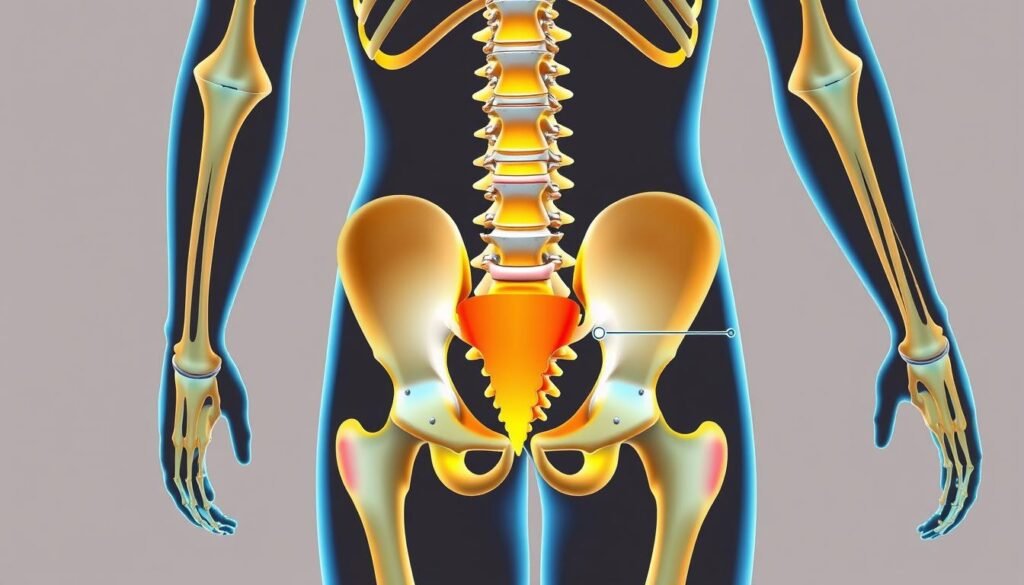
Knowing how the SI joint works is key. It helps us find the right exercises to ease SI joint pain and keep it working right.
Several things can make the SI joint hurt. These include:
People with lower cross syndrome are also at risk. This is when the muscles in the belly and glutes are weak, and the hip flexors and lower back muscles are tight. Doing lower cross syndrome remedies can help fix these muscle imbalances and lower the chance of SI joint problems.
The main signs of SI joint pain are:
Exercises like hip flexion and extension isometric holds help with SI joint pain3. These sciatica relief exercises should be done a certain number of times a day. The number of reps and how long to hold depends on what each person needs3.
Doing a regular exercise routine can make a big difference in three weeks4. This routine should include stretches for the SI joint, exercises to build strength, and some light aerobic activities.
Understanding SI joint pain helps people manage it better. Working with a healthcare professional or physical therapist is key. They can create a plan that includes exercises and other treatments. People with SI joint problems usually see a physical therapist about three times a week for a few weeks5.
Regular exercise is a great way to ease sacroiliac (SI) joint pain and keep your hips moving well. Adding specific exercises for the SI joint and hip drills to your day can really help. A study by Hinge Health found that people in a 12-week physical therapy program had a 68% drop in pain6.
Stretching is key to keeping the SI joint flexible and improving mobility. Simple stretches like the knee-to-chest stretch and the double knee-to-chest stretch can help a lot7. The figure four stretch also helps by loosening the muscles around the SI joint7.
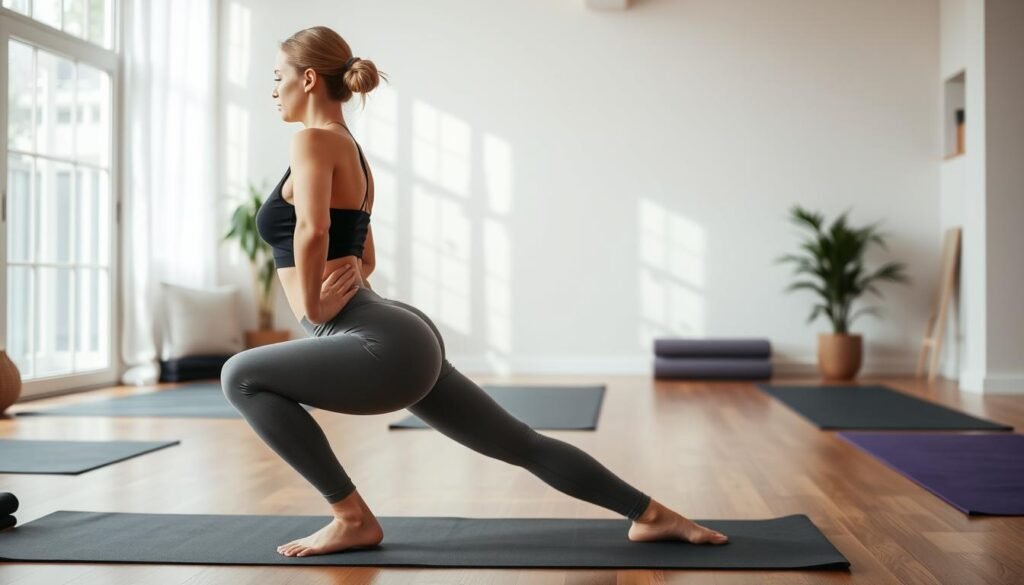
Strengthening exercises are also important for keeping the SI joint stable and improving pelvic stability. Hinge Health physical therapists suggest exercises that build core and glute strength6. The adductor squeeze and band abduction exercises are good for these muscles7.
Mixing stretching and strengthening exercises into your daily routine can make a big difference. These exercises not only ease pain but also help prevent SI joint problems. Spending just a few minutes each day on these exercises can boost your mobility, cut down on pain, and enhance your life quality.
Stretching can help ease SI joint pain and boost mobility. It targets muscles around the SI joint, reducing tension and improving flexibility. About 25 percent of lower back pain comes from the SI joint8. Adding stretching to your daily routine can help your SI joint feel better.
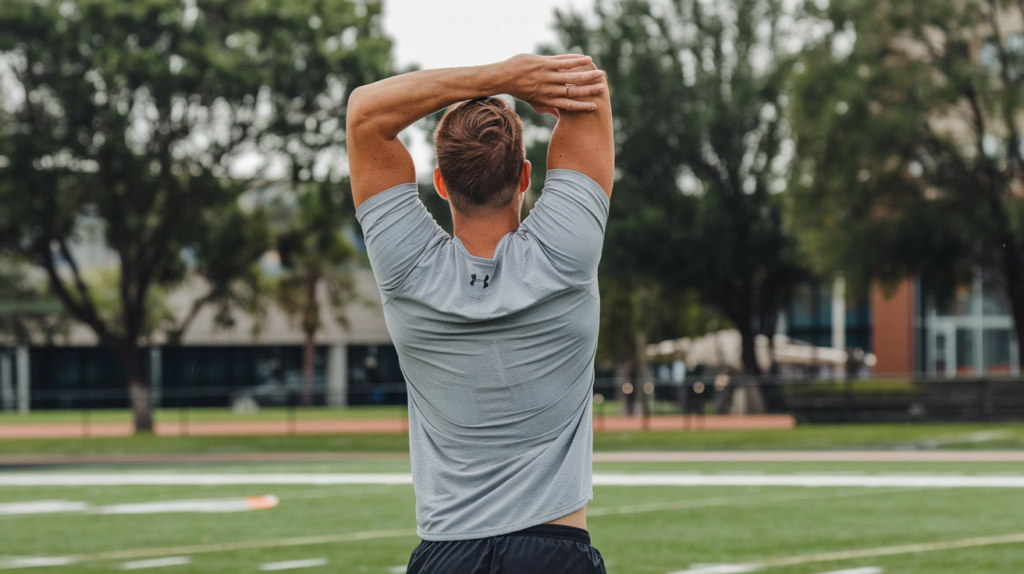
Tight hamstrings can make SI joint pain worse by adding stress to the lower back and pelvis. To stretch, lie on your back and lift your injured leg up towards the ceiling. Keep the other leg flat. Use a towel or band to pull your leg closer, stretching your thigh’s back.
Hold each stretch for 15 to 30 seconds, except for hamstring stretches. Those should last at least 1 minute, increasing up to 6 minutes2.
The hip adductors, or inner thigh muscles, can get tight and cause SI joint pain. To stretch, lie on your back with knees bent and feet flat. Slowly spread your knees apart, letting gravity pull them down. You’ll feel a stretch in your inner thighs.
Hold for 15-30 seconds and do 2 to 4 times2.
The piriformis muscle in your buttocks can get tight and irritate the SI joint. To stretch it, lie on your back with knees bent. Cross your affected leg over the other thigh, making a figure-4. Pull your crossed leg towards your chest until you feel a stretch.
Hold for 30 seconds and repeat 2 to 4 times2.
Lower back and hip pain are common symptoms of SI joint dysfunction, and difficulty standing or sitting for extended periods is also a symptom9.
Stretching your quadriceps can ease tension in the front of your hips and improve SI joint alignment. Stand with feet hip-width apart and bend one knee, bringing your heel towards your buttocks. Grasp your ankle and pull your heel closer, keeping your knees together.
Hold for 15-30 seconds and repeat on the other side.
Remember to breathe deeply during each stretch and avoid bouncing or forcing the movement beyond your comfort level. Aim to gradually increase the duration of each stretch over time, working up to holding them for 30 seconds to 1 minute. It’s important to listen to your body and respect any pain or discomfort you may experience. SI joint pain is common during pregnancy due to the production of a hormone called relaxin that makes joints more elastic, allowing the pelvis to widen during childbirth8.
Disclaimer: This page contains affiliate links. If you choose to make a purchase after clicking a link, I may receive a commission at no additional cost to you. Thank you for your support!
Strengthening exercises are key to keeping the sacroiliac (SI) joint stable. The SI joints bear the torso’s weight, help balance while walking, and cushion the spine10. About 15% to 30% of lower back pain comes from SI joint instability, also known as Sacroiliac Dysfunction1011. Doing specific exercises can ease pain and boost joint function.
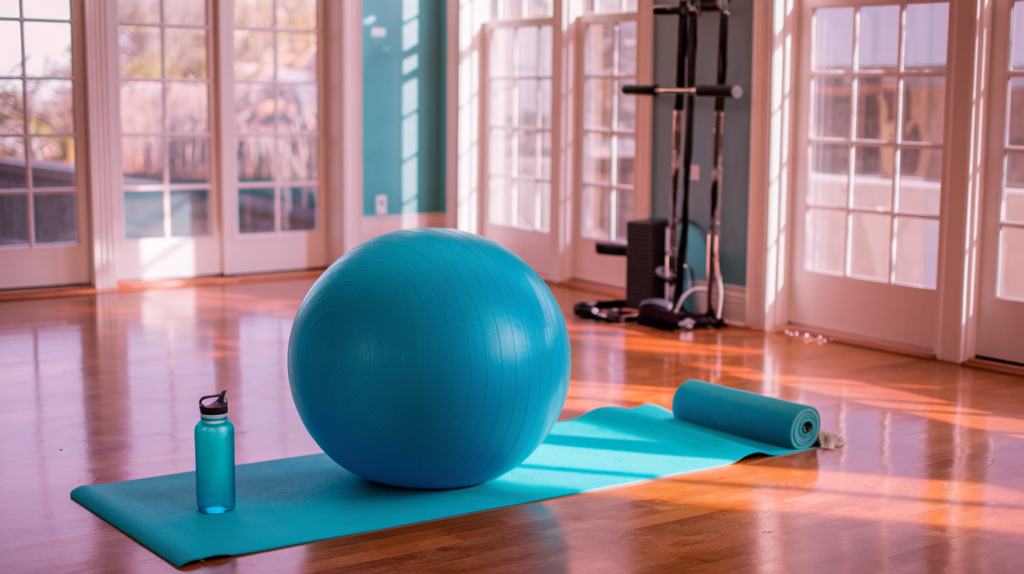
The gluteal muscles are vital for SI joint support. Lying on your stomach and squeezing your buttocks strengthens these muscles and enhances stability. Gluteus Medius Strengthening exercises are especially good for the muscles around the SI joint10.
A strong core is crucial for SI joint stability. Routines like lower trunk rotations, knee-to-chest stretches, and core isometric exercises with resistance bands work the abdominal muscles. These exercises help spread the load evenly across the joint and reduce stress on the SI joint10.
The back bridge stretch is great for the muscles around the SI joint. Lie on your back with knees bent and feet flat. Slowly lift your hips off the ground while squeezing your buttocks. Hold for a few seconds before lowering back down. This targets the gluteal muscles and boosts SI joint stability.
The hip adductor muscles, on the inner thighs, also support SI joint stability. Isometric hip adductor stretches involve sitting on the floor with a pillow between your knees and gently squeezing for several seconds. This strengthens the hip adductors and helps align the SI joint properly.
While these exercises are very helpful, Sacroiliac Dysfunction is a chronic condition with no quick fix11. Being consistent and patient is essential when adding these exercises to your routine. Always talk to a healthcare professional or a qualified physical therapist to make sure you’re doing the exercises right and get personalized advice.
Yoga can help ease si joint pain by stretching and strengthening. But, it’s key to do the poses right and not overdo it. Wrong yoga poses can make SI joint pain worse12.
Using pelvic floor muscles and support under the thighs in some poses can help. This reduces pressure on the SI joint and prevents more pain13.
Women are more likely to have sacroiliac pain than men. This is due to structural and hormonal differences13. Hormonal changes during menstruation, pregnancy, and lactation can also cause more pain1312.

The cobra pose is done by lying on your stomach and lifting your upper body. It’s a gentle backbend that stretches and strengthens the muscles around the SI joint. Doing simple backbends like the cobra can help prevent SI joint problems13.
In the locust pose, you lift your head, upper body, arms, and legs off the floor. Your lower ribs, stomach, and front pelvis stay on the ground. This pose strengthens the muscles around the SI joint and improves stability.
The bow pose is done by lying on your stomach, bending your knees, and reaching back to grab your ankles. You then lift your feet and upper body. This pose stretches the front of your body and strengthens your back muscles, supporting the SI joint. But, it’s important to twist from the organs in the front, not the spine, to get the most relief12.
When doing yoga for si joint pain, listen to your body and adjust poses as needed. Therapeutic movements, like standing near a wall or lying on your back with specific leg movements, have shown to be effective12. If pain continues, get help from a qualified yoga instructor or healthcare professional.
Low-impact exercises can help those with sacroiliac (SI) joint pain. About 25 percent of lower back pain comes from SI joint irritation8. Women are 8-10 times more likely to have SI joint pain than men14.
SI joint pain gets more common with age. But injuries and diseases can cause it in anyone15.
Gentle exercises can ease discomfort and support the SI joint. These exercises often come from pilates and yoga. They improve flexibility, balance, strength, and stability14.

Water workouts, like aquafit and water aerobics, are done in the shallow pool. They strengthen muscles without stressing the joints too much. The water’s buoyancy helps the body, reducing stress on the SI joint.
These exercises are great for those with limited mobility or severe SI joint pain.
Walking at a comfortable pace can ease joint and back pain. It’s a low-impact activity that boosts blood flow and strengthens muscles. It also helps keep a healthy weight.
Active people are more likely to get SI joint pain15. Regular walks can help prevent and manage SI joint issues.
Short bike rides can improve blood flow without overloading the SI joint. But, it’s important to keep good posture and avoid long biking sessions. This can make SI joint pain worse.
It’s key to avoid certain activities to prevent SI joint pain. These include crunches, heavy weight lifting, twisting or turning exercises, and prolonged biking14.
When starting low-impact exercises, listen to your body and go slow. Recommended exercises include the knee-to-chest stretch, knee rotations, and the bridge exercise. Cobra pose, child’s pose stretch, and bird dog exercise are also helpful14.
These exercises strengthen glutes, lower back, and abdominal muscles. This helps support the SI joint and relieve pain14. Strengthening glutes is especially helpful for those with persistent SI joint pain and weak glutes8.
Disclaimer: This page contains affiliate links. If you choose to make a purchase after clicking a link, I may receive a commission at no additional cost to you. Thank you for your support!
If you have sacroiliac (SI) joint pain, it’s important to know which exercises can make it worse. SI joint pain often hurts on one side of the pelvis and can feel dull or sharp16. Activities like stair climbing, using the elliptical, or long walks can make the pain worse16.
There are certain exercises you should avoid to not irritate the SI joint. Stay away from sit-ups, crunches, planks, running, tennis, golf, leg lunges, jumping rope, and cardio machines17. Also, avoid deep single-leg stretches like “figure four” or “pigeon pose” as they can cause pain16. Sitting cross-legged can also pull the pelvis out of alignment, making SI joint issues worse16.

During pregnancy, hormonal changes can make the SI joint more mobile16. The extra weight during pregnancy adds to the forces on the pelvis, making SI joint pain worse16. After giving birth, hormonal changes can still make the SI joint hypermobile, leading to pain16.
To manage SI joint pain, consider the following table of recommended exercises and those to avoid:
| Recommended Exercises | Exercises to Avoid |
|---|---|
| Swimming (low-impact, full-body workout) | Sit-ups and crunches |
| Cycling (if done correctly) | Planks |
| Bridges and clamshells (targeting glutes) | Running and jumping rope |
| Gentle stretching | Tennis and golf |
| Leg lunges and deep single-leg stretches | |
| Cardio machines (elliptical, stair climber) |
Identifying what triggers your SI joint pain is key to creating the right exercise plan16. Things that can make SI joint pain worse include bad posture, overdoing activities without warming up, and high stress17. A mix of exercise therapy and chiropractic care is the best way to treat SI joint pain17.
Managing sacroiliac (SI) joint pain requires a mix of stretching, strengthening, and low-impact exercises. A person can have dysfunction in one or both sacroiliac joints18. Research shows the sacroiliac joint is a common cause of chronic back pain19. It’s often hard to diagnose and is often overlooked as a source of discomfort19.
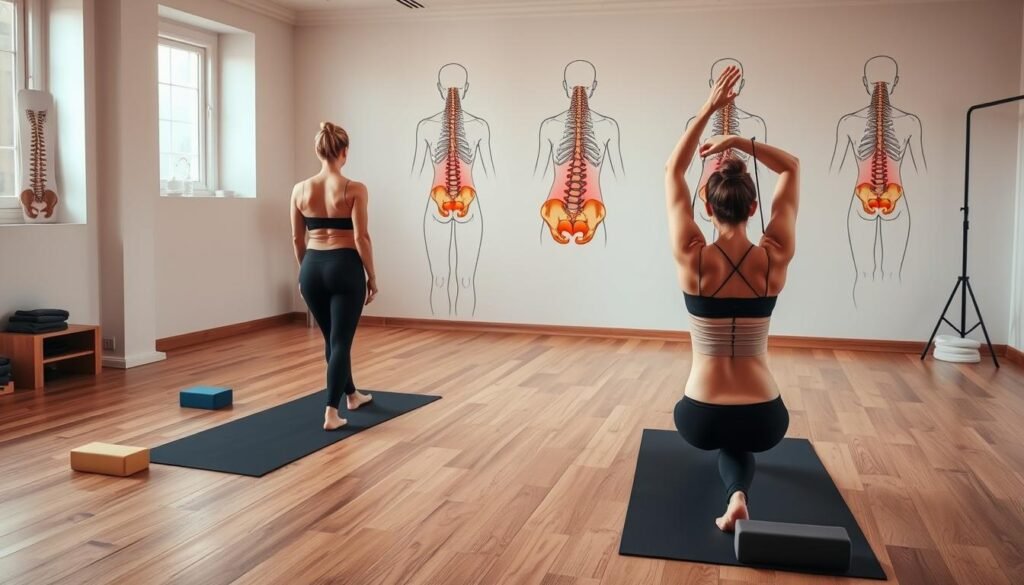
The sacroiliac joint is the largest synovial joint in the body. It allows for movement but has limited motion19. SI joint pain can be caused by pregnancy, trauma, osteoarthritis, or age-related issues18. Injuries from falls, car accidents, and sports can also contribute to SI joint pain19.
Conditions like osteoarthritis, gout, ankylosing spondylitis, pregnancy, leg length discrepancy, and scoliosis can also cause SI joint pain19.
Exercises like foam roll massage, hip flexor stretch, and lower trunk rotation can help with SI joint pain19. These exercises should be done 10 to 20 times, or for 30 to 60 seconds18. It’s important to do these exercises intensely and regularly, aiming for 6 days a week for 3 weeks19.
Working with orthopedic specialists can help create a personalized exercise plan. This may include stretching, strengthening, physical therapy, and SI joint injections. SI joint pain can feel like lower back pain, buttock pain, groin pain, thigh pain, or leg pain19. It can also feel similar to herniated discs18.
It’s crucial to work with healthcare professionals to develop a treatment plan. This ensures the best results for managing SI joint pain.
Research offers various options for diagnosing and managing sacroiliac joint pain, including interventional pain management and injections19. By taking a comprehensive approach to si joint pain exercises and tailoring them to individual needs, those suffering can find relief and improve their quality of life.
While exercises for si joint pain can help, it’s key to find the cause of SI joint dysfunction. Home treatments and exercises can ease SI joint pain20. Applying heat or ice for 10 to 20 minutes can help20. Heat therapy includes warm water bottles, heating pads, or warm cloths21. Cold therapy uses ice or cold packs for 10 to 20 minutes21.
Over-the-counter pain medicines like acetaminophen, ibuprofen, or naproxen should be taken as directed20. They might be suggested for pain relief21. Prescription pain medicines should be followed as prescribed20 by the doctor21. Doing exercises to stretch and strengthen the back and stomach can prevent future back pain20. Light exercises are also suggested to ease back pain21.
If pain doesn’t get better or gets worse, seeing a doctor is a good idea. Chronic SI joint pain can last over three months22. It’s important to follow the right exercise routines to stretch and strengthen the back and stomach muscles to prevent future back pain21.
Healthcare providers can give a correct diagnosis and suggest the right treatment. This can include:
After SI joint fusion surgery, patients might need to use crutches for weeks and avoid full weight on the operated side22. It’s important to use proper lifting techniques, maintain good posture, exercise regularly, and manage stress to prevent SI joint pain from coming back22.
It’s important to keep up with follow-up care for treatment and safety21. Call 911 if you can’t move a leg at all20. If you have new or worse symptoms in the legs or buttocks like numbness, tingling, weakness, or pain, or loss of bladder or bowel control, seek immediate medical care20. Contact your doctor if you’re not getting better as expected or notice any health changes20.
Sacroiliac joint pain is more common in pregnant women20, and joint pain in the sacroiliac joints is more common during pregnancy21. Certain kinds of arthritis can also cause sacroiliac joint pain20, and certain types of arthritis can also lead to sacroiliac joint pain21.
| Treatment | Description |
|---|---|
| Physical Therapy | Physiotherapy, including exercises and stretches, is recommended for managing sacroiliac joint pain21. |
| Medications | Over-the-counter pain medicines such as acetaminophen, ibuprofen, or naproxen may be recommended for pain relief21. Prescription pain medicine should be taken as prescribed by the doctor21. |
| Joint Injections | Joint injections involving corticosteroids can be repeated up to three times a year22. |
| Radiofrequency Ablation | Successful SI joint injections may lead to radiofrequency ablation as a treatment option22. |
| SI Joint Fusion Surgery | Minimally invasive SI joint fusion surgery typically takes about an hour22. |
SI joint pain can be tough, but exercises can help a lot. Try stretching exercises like hamstring stretches for 15 to 30 seconds23. The piriformis stretch should be held for 15 to 30 seconds and done 2 to 4 times on each leg23. This can make your SI joint area more flexible and less painful.
Strengthening exercises, like glute exercises, are also helpful. Try the bridging and clamshell exercises for about 6 seconds, repeating 8 to 12 times23. These can help stabilize your SI joint and ease pain.
Low-impact activities like water workouts, walking, and biking are good for your SI joint. Remember, while exercise and physical therapy work well, you might not see results right away24. To manage lower back pain, avoid sitting for too long, support your back while sitting, keep a moderate weight, and sleep curled up on one side24.
Combining stretching, strengthening, and low-impact exercises is the best way to get results. If your pain doesn’t get better, you might need to see a doctor. They can suggest treatments like pelvic floor therapy25 or the LinQ SI Joint Stabilization System. By focusing on the right exercises, you can manage your SI joint pain and move better.
The best exercises for sacroiliac joint pain relief include stretching, strengthening, and low-impact exercises. Stretching exercises like hamstring and hip adductor stretches can improve flexibility. Strengthening exercises, such as glute and core exercises, help stabilize the joint.
Low-impact exercises like walking and biking increase blood flow without overloading the joint.
Symptoms of sacroiliac joint dysfunction include lower back and hip pain. You might also have trouble standing or sitting for long periods. Other signs include numbness in the legs and muscle tightness in the hips or buttocks.
If you experience these symptoms, see a healthcare professional for a proper diagnosis and treatment plan.
Yes, yoga can help with SI joint pain relief. Poses like cobra and locust can stretch and strengthen the muscles around the joint. But, do these poses correctly to avoid further irritation.
Avoid activities that can make SI joint pain worse. Sit-ups, abdominal crunches, and sports like golf and tennis are examples. Also, avoid lifting heavy weights or objects.
Any activity that twists and turns at the hips or involves physical contact should be avoided.
Adding SI joint stretches to your daily routine can improve mobility. Stretching in the morning and evening can help with SI joint pain. Hold each stretch for 15-30 seconds and repeat several times.
Consistency is key to seeing the best results.
If your pain doesn’t get better with stretching and strengthening, seek medical help. Healthcare providers can diagnose and recommend treatments like physical therapy or SI joint injections.
They might also suggest innovative treatments like the LinQ SI Joint Stabilization System by PainTEQ.
Yes, strengthening exercises are crucial for SI joint stability. Focus on exercises that target the glutes, core, and hip adductors. Glute and core exercises, along with back bridge stretches, can support the joint.
Isometric hip adductor stretches also help engage the muscles around the SI joint.
Low-impact exercises are great for SI joint health. Water workouts, like aquafit, strengthen muscles without stressing the joints. Walking and short bike rides also help by increasing blood flow without overloading the joint.
Managing SI joint pain through exercise requires a mix of stretching, strengthening, and low-impact activities. Work with orthopedic specialists to create a personalized program. This might include stretching, strengthening routines, physical therapy, and SI joint injections.
Collaborating with healthcare professionals is key to developing an effective treatment plan.